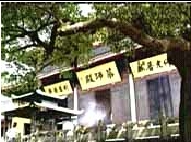|

Built in 326 AD by a
senior indian monk named
Huili, Lingyin
Monastery, or the
Monastery of Soul’s
Retreat, is one of
China’s largest temple
complexes. It has been
destroyed 16 times in
its long and checkered
history. The Great Hall
is a mix of late Qing
and early Yuan Dynasty
relics, with a few more
recent additions too.
And now, it is very much
a working monastery.
The temple is located in
a long, narrow valley
between two peaks. A red
wall in the middle of
the valley seems to
lengthen the distance,
adding to the mystery of
the monastery, which
seems to be hidden.
Hence the name, the
"Monastery of Sole’s
Retreat"
The Mahayana Hall of
Lingyin Monastery houses
China’s largest wooden
sculpture of the
Sleeping Buddha, which
stands 9.1 meters in
height. Including the
lotus seat and the top
of Buddhist Glory, the
entire statue measures
19.6 meters in height.
In front of the
monastery, there are
Feilai Peak, Cold
Spring, Longhong Cave,
precious rock cave arts,
queer and varied natural
caves and gullies.
Inside the caves of the
Flown Over Peak are 470
Buddhist statues
sculpted during the Five
Dynasties, Song and Yuan
dynasties (907-1368).
They are the most famous
of the Esoteric Buddhist
statues in China. |